Действительно ли Dwell Time является фактором ранжирования?
- 1 Что такое «Dwell Time»?
- 2 Краткая история Dwell Time
- 3 Является ли Dwell Time фактором ранжирования Google?
- 3.1 (Возможно) это выдумка, что показатель отказов является фактором ранжирования
- 3.2 Почему не стоит полагаться на Dwell Time в качестве фактора ранжирования
- 3.3 Стоит ли вам попытаться улучшить Dwell Time? (И если да, то как?)
- 3.4 1. Создайте ЛУЧШИЙ контент… Примерно от 2 до 10 тыс. символов
- 3.5 2. Задавайте правильные ключевые слова (и НЕ ИСПОЛЬЗУЙТЕ “Clickbait”)
- 3.6 3. Сайт медленно загружается? Навязчивая реклама? ХВАТИТ! Сделайте UX/UI своим главным приоритетом!
- 3.7 4. Небольшое количество внутренних ссылок на протяжении всего вашего контента будет кстати… но убедитесь, что они уместны!
- 3.8 5. ВСЕГДА следите за актуальностью вашего контента (Несвежий контент =Провал!)
Google использует более 200 факторов ранжирования, и одним из таких факторов является «Dwell Time». Но является ли «Dwell Time» фактором ранжирования? Правда заключается в том, что «Dwell Time» – очень запутанный и часто неправильно понимаемый критерий.
Что подразумевается под термином «Dwell Time»? Как измеряется «Dwell Time»? Действительно ли «Dwell Time» является фактором ранжирования? И если да, то как его оптимизировать? В этой статье вы найдете ответы на все эти вопросы и еще много чего интересного.
Также в статье мы ссылаемся на некоторых известных экспертов в индустрии SEO, чтобы разобраться в этом вопросе. Давайте же начнем!
Что такое «Dwell Time»?
«Dwell Time» – это время, которое проходит от момента нажатия на ссылку из результатов поиска до возвращения пользователя к этой же странице результатов поиска.
Пример:
Предположим, что я ввожу в поисковую строку фразу «white hat link building». Я нажимаю на первый результат и трачу несколько минут, изучая содержимое (точнее, 5 минут 14 секунд).
Поскольку у меня есть нездоровая тяга к знаниям, я понял, что хочу узнать еще больше. Итак, я возвращаюсь к странице с результатами поиска (через кнопку «назад» в моем браузере), чтобы найти больше познавательной информации.
Примечание: Описанный промежуточный процесс, между тем как пользователь заходит на сайт, выбрав его в результатах поиска и возвращается к главной странице с результатами поиска также известен как pogo-sticking.
Я находился на этой странице на протяжении 5 минут 14 секунд. Но почему это важно для SEO?
Краткая история Dwell Time
Dwell Time была впервые упомянута Дуэйном Форрестером в своей публикации в блоге на платформе Bing Webmaster в 2011 году. На тот момент Форрестер был старшим менеджером проектов Bing.
Вот что он написал:
[…] Промежуток времени между тем, когда пользователь нажимает на нашу ссылку в результатах поиска и когда он уходит с нашего сайта, может нам многое рассказать. Минута или две – хороший показатель, так как это говорит о том, что ваш контент был полезен пользователю. Если он провел на вашем сайте пару секунд, то это можно считать плохим показателем.
Дуэйн Форрестер, старший менеджер проектов Bing
Но все же, почему это действительно важно для поисковых систем?
Вот что ответил на это Дуэйн:
Ваша цель должна состоять в том, чтобы контент соответствовал потребностям пользователя, когда тот зашел на вашу страницу. Этим вы поспособствуете тому, что пользователь останется на вашем сайте. Если ваш контент их не заинтересует, они покинут страницу. Поисковые системы могут отслеживать это, наблюдая за Dwell Time на сайте.
Дуэйн Форрестер, старший менеджер проектов Bing
Хорошо. Это имеет смысл. Основная идея этого такова, что чем дольше пользователь остается на вашем сайте, тем больше вероятность, что ваш контент оказался полезным.
Теперь я приведу несколько примеров Dwell Time на сайте и как их можно истолковать:
- 2-х секундная Dwell Time: пользователь не нашел то, что хотел/ожидал увидеть на вашем сайте, поэтому быстро вернулся к странице с результатами поиска, чтобы найти что-то получше.
- 2-х минутная Dwell Time: пользователь нашел ваш контент довольно полезным и застрял на пару минут, чтобы ознакомиться с ним.
- 15-х минутная Dwell Time: пользователь нашел ваш контент очень полезным и приложил немало сил, чтобы изучить изложенную вами информацию.
Таким образом, можем предположить, что поисковые системы могут использовать время ожидания как фактор ранжирования. Кажется, это хороший способ оценить качество и значимость данного результата, не так ли?
Больше о времени пребывания на сайте в качестве ранжирующего фактора вы узнаете чуть позже в этой статье, но сначала давайте кое-что проясним.
«Dwell Time», «Показатель Отказов» и «Время на Странице»: в чем разница?
Невозможно объединить в одно слово эти 3 термина, из-за этого может возникнуть путаница. Фактически, я видел, как в сфере SEO, эти 3 термина используются поочередно.
Эти 3 термины не взаимозаменяемы!
Сейчас я объясню вам простым языком, что означает каждый из этих терминов:
- Dwell Time – это количество времени, которое проходит между моментом, когда пользователь нажал на результат поиска и до того, как он нажмет на «стрелку назад», чтобы вернуться обратно к странице с результатами поиска.
- Показатель отказов – это процент одностраничных сеансов (т.е. пользователи, которые переходят только на одну страницу на вашем сайте перед уходом). Эти люди, возможно, вернулись к поисковым запросам или просто закрыли страницу. Неважно, что именно произошло. Также не имеет значения, провели ли они на сайте 2 секунды или 2 часа, все равно это «отказ».
- Время на странице – это количество времени, которое пользователь потратил на вашей страницу, прежде чем отправиться в другое место. Возможно, он вернулся к поисковым запросам, перешел на другую страницу вашего сайта или на страницу из закладок – куда угодно.
Также стоит отметить, что время на странице и показатель отказов можно просмотреть в Google Analytics:
Вы не найдете такой информации по Dwell Time. Если компания Google и использует какой-либо показатель времени в качестве фактора ранжирования, то она не размещает такую информацию (как и другие данные).
Является ли Dwell Time фактором ранжирования Google?
Еще не поступало официального заявления Google о том, является ли Dwell Time фактором ранжирования. Но в конце 2017 года глава Google Brain , Ник Фрост, сказал про это на конференции:
Сейчас Google использует машинное обучение чтобы [определить взаимосвязь между поиском и лучшей страницей в этом поиске]. Учебные модели отслеживают переход пользователя на страницу, пребывания его на странице, выход пользователя со страницы, и пытаются определить взаимосвязь между этими действиями.
Ник Фрост, глава Google Brain
Это подтверждает мнение о том, что время пребывания является фактором ранжирования. Но, как отметил Кир Шепард в Twitter , это не совсем так.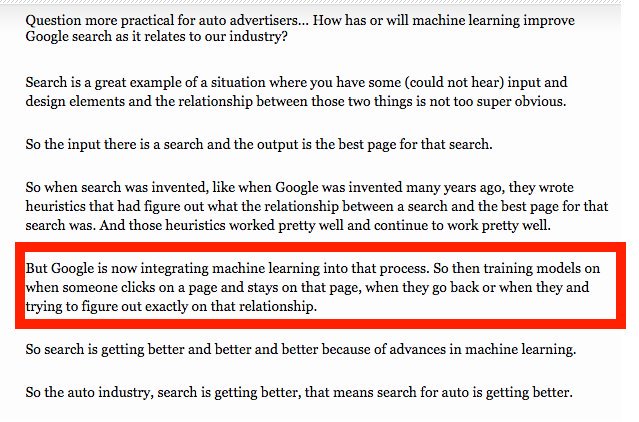
Чтобы уточнить, никто в Google не говорил, что Dwell Time + показатель отказов были факторами ранжирования, но они являются каналами машинного обучения. Google Brain – это исследовательский проект Google по изучению системы искусственного интеллекта на основе глубокого обучения.
Они не занимаются алгоритмами ранжирования. В связи с этим, нет доказательств, что Dwell Time является фактором ранжирования. Хотя, также стоит помнить, что большинство людей никогда не выходит за первую страницу результатов поиска.
Поэтому, если ваш сайт занимает место на второй странице (или даже дальше), почти никто не будет посещать вашу страницу … даже на секунду.
Это значит, что Dwell Time будет работать только в качестве (возможного) коэффициента ранжирования только для результатов в топ-10.
Ваш сайт на последних страницах результатов? Если пока ваш сайт не на первой странице, не стоит беспокоиться об оптимизации времени ожидания. Лучше потратьте ваше время на оптимизацию других (более важных) факторов, которые помогут вам войти в топ-10.
Тем, кто уже на первой странице, стоит знакомиться с тремя причинами по которым Dwell Time важен, как фактор ранжирования. Давайте сделаем поисковый запрос «paleo diet for beginners».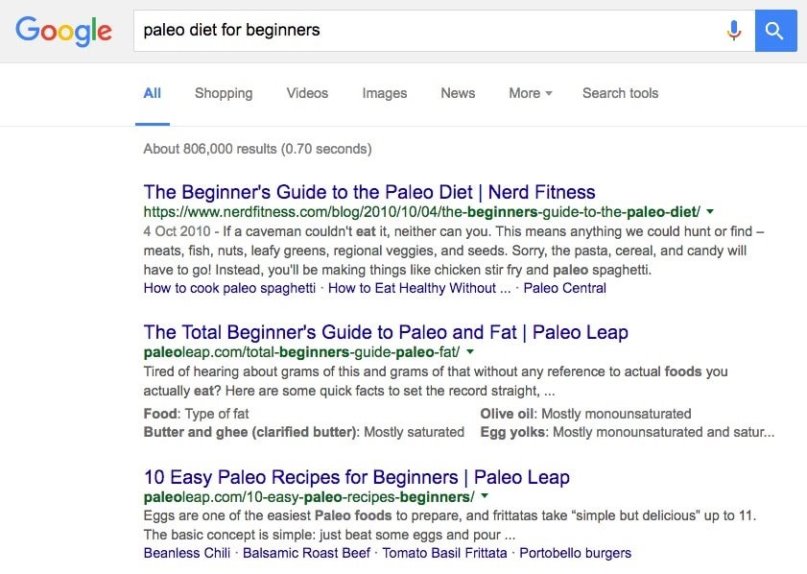
Все, кто ищут это, явно являются новичками в палео. Они ищут руководство для новичков. На первом месте (на момент написания этой публикации) у нас есть именно это – руководство для начинающих от NerdFitness:
Если вы когда-либо читали это руководство, то должны знать, насколько оно обширно. Оно охватывает почти всю информацию, которую только можно найти о диете палео на одной странице. Статья отлично написана и вполне презентабельна.
В целом, результат полностью соответствует тому, что мы хотели найти. Большинство людей наверняка проведут 15+ минут, читая эту статью (возможно), до того как вернуться к странице с результатами поиска.
Для сравнения, давайте посмотрим на эту страницу (рейтинговое место №6 для того же запроса, на момент публикации).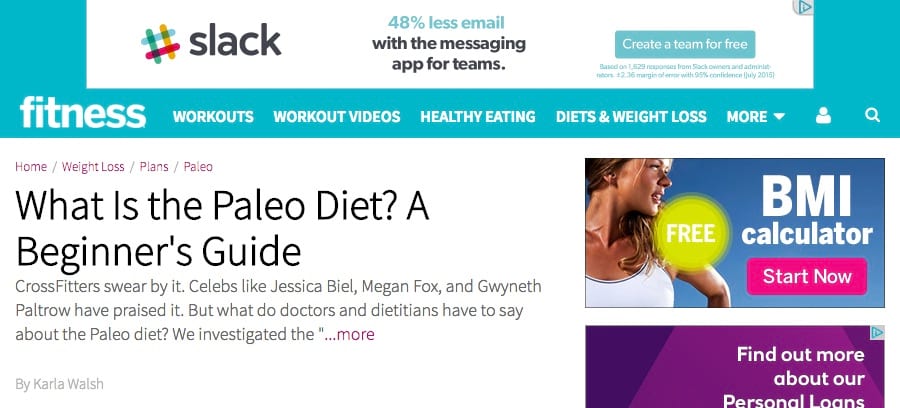
Не нужно тратить много времени, чтобы понять, что этот сайт выполнен гораздо хуже, в сравнении с руководством от NerdFitness.
Сразу можно сделать несколько замечаний:
- Контент достаточно скудный: примерно 500 слов;
- Информация слишком проста;
- Сайт облеплен объявлениями.
Из-за этого можно предположить, что среднее Dwell Time для этой страницы будет ниже 30 секунд. Вывод: время ожидания, по-видимому, является хорошим показателем актуальности и качества данного результата.
(Возможно) это выдумка, что показатель отказов является фактором ранжирования
Мягко говоря, рассматривать показатель отказов как фактор ранжирования весьма сомнительно. Потому что «отказы» от людей могут поступать по ряду причин, таких как:
- Нет необходимости посещать более, чем 1 страницу – все, что им было нужно, они нашли на одной странице;
- Режим ожидания в течение 30+ минут запускает новый сеанс в Google Analytics;
- Бедный контент– он не нравится пользователям и они уходят.
Если бы система пыталась соответствовать целям пользователей только по показателю отказов, это бы затруднило распознавание хорошего и плохого интерфейса. Чтобы проиллюстрировать это, давайте вернемся к нашему предыдущему примеру («палео»).
При обоих посещениях страниц сработал «отказ» по техническим причинам, но опыт был совершенно разным для этих сайтов (на одном положительный, на другом – отрицательный). Вот как эти два посещения выглядят в Google Analytics:
Это 15-ти минутный сеанс в NerdFitness:
А вот 30-ти секундное посещение FitnessMagazine:
Мало того, что эти два (в действительности, очень разные) сеанса кажутся одинаковыми, также указано время, проведенное пользователем на странице, и оно равно 0 секунд.
Ясно, что это неверная информация. Почему так происходит? Для того чтобы сервис Google Analytics вычислил время, проведенное пользователем на странице, ему нужно два клика: щелчок на входе и щелчок на выходе. Если нет клика на выходе (например, пользователь перешел на другую страницу вашего сайта), GA (Google Analytics) не может выполнить расчет.
Вот отличное объяснение от AnalyticsEdge.com:
Для сеансов, в которых пользователь просматривал только одну страницу («отказ»), время на странице и продолжительность сеанса равны 0. Это происходит не потому, что Google знает, что они ушли сразу, а потому что у них не было никаких указаний, когда именно пользователь ушел, поэтому они не могут рассчитать время на странице, и из-за недостатка информации рассматривают время, проведенное на сайте, как нулевое.
Далее специалисты из Google Analytics пишут:
Время, проведенное на странице, может составлять 10 секунд или 10 минут; они наверняка не знают сколько, поэтому они указывают 0. Прочитал ли пользователь вашу страницу? Им это не известно. Может быть да, а может и нет. Все, что им известно, это то, что пользователи не смотрели на другую страницу вашего сайта в течение следующих 30 минут (столько длится сеанс по умолчанию).
Еще одна большая проблема в использовании показателя отказов, как фактора ранжирования заключается в том, что тогда Google должен будет использовать данные Google Analytics для ранжирования.
Но официальная позиция компании Google заключается в том, что она не используют никаких данных GA для ранжирования. А другого способа для определения показателя отказов страницы не существует.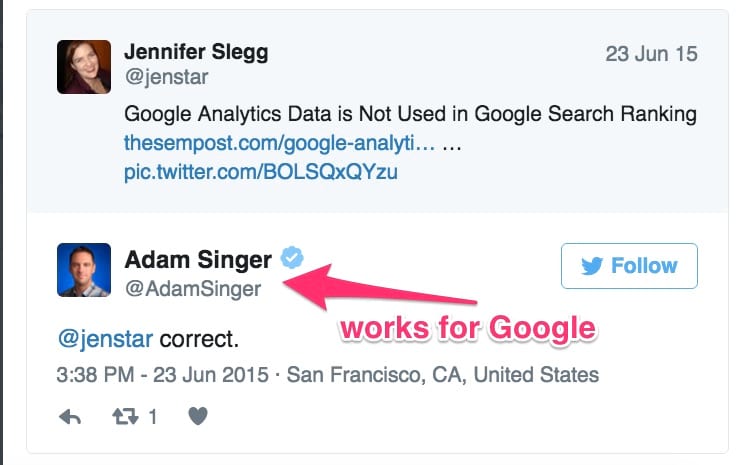
Таким образом, исходя из признания Google, показатель отказов не является фактором ранжирования. Возможно, не стоит принимать все слова Google за истину, но в этом случае они, скорее всего, говорят правду.
Вот три причины, почему это так:
- Не каждый использует GA: в 2012 году, по оценкам, около 10 миллионов сайтов использовали Google Analytics. Даже если это число выросло в десять раз с тех пор (что, скорее всего, не так), это все равно составляет всего 10% от количества всех сайтов. Сможет ли Google действительно расшифровать все, что имеет истинное значение, используя анализ показателей отказов всего на 1/10 сайтов мира? Может быть, но я подозреваю, что данные будут в основном бесполезными;
- GA часто установлена неправильно: любой, кто когда-либо проводил SEO-аудит, знает, насколько важно проверить, чтобы GA была установлена правильно. Это распространенная проблема, которая часто может приводить к увеличению частоты отказов. Это были бы неточные данные для Google;
- Блокировщики рекламы часто блокируют код GA: по оценкам, 30% пользователей имеют блокировщик рекламы и почти у всех этих пользователей сайт Google Analytics находится по умолчанию в черном списке. Они также блокируют любые действия, которые поступают от библиотеки JavaScript GA. Если бы Google тайно использовал код GA, это были бы неполные данные – примерно ⅓.
Таким образом, даже если Google тайно анализирует данные о показателях отказов от GA, скорее всего, это не будет иметь особого значения. Поэтому время ожидания (теоретически) превосходит показатель отказов в качестве фактора ранжирования – данные о времени ожидания легче собрать, особенно для Google.
Вот почему: предположим, что вы вводите в поисковую строку Google «iPhone 8 review».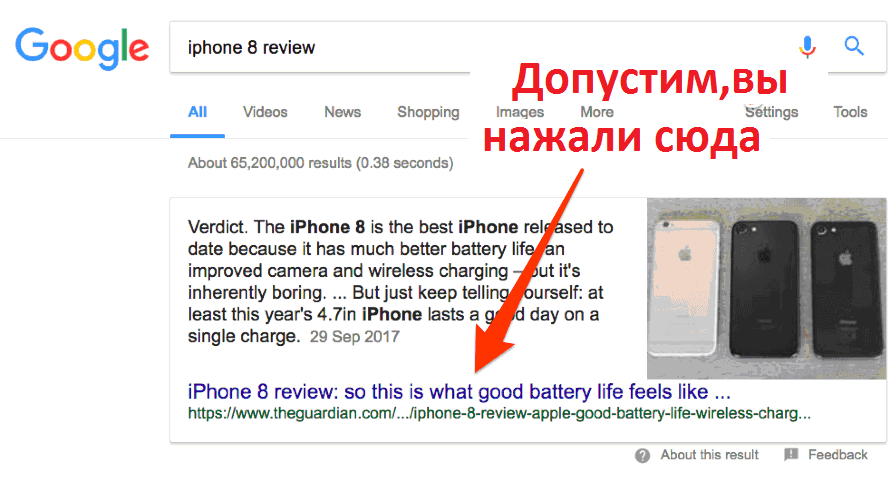
Если/когда вы нажмете результат, Google запустит «виртуальный секундомер». И когда вы вернетесь к странице с результатами поиска, Google остановит его. Теперь они точно знают, сколько времени вы потратили на этот сайт (т.е. Dwell Time).
Если вам интересно, как Google узнает, когда вы вернетесь к результатам поиска, то у нас есть пару идей:
- Данные браузера Chrome: По последним данным от W3Schools, 72,4% пользователей используют теперь Chrome. Chrome – это собственный браузер компании Google, поэтому они, по всей видимости, знают, когда вы нажимаете кнопку «Назад» и возвращаетесь к результатам поиска.
- Анализ «следующего клика»: если вы вернетесь к поисковым запросам, это, предположительно, будет всего на пару секунд, прежде чем вы перейдете к другому результату. Google может дождаться этого клика и, таким образом, расшифровать приблизительное время ожидания для вашего предыдущего клика.
Понятно, что с помощью небольшого количества добытых данных, Google может раскрыть некоторые полезные данные для анализа Dwell Time. Попробуйте сделать это:
Откройте Safari на вашем iPhone и введите в поисковой строке фразу «link building strategies». Лучший результат по этому запросу у «Moz» (он должен быть в топ- 3):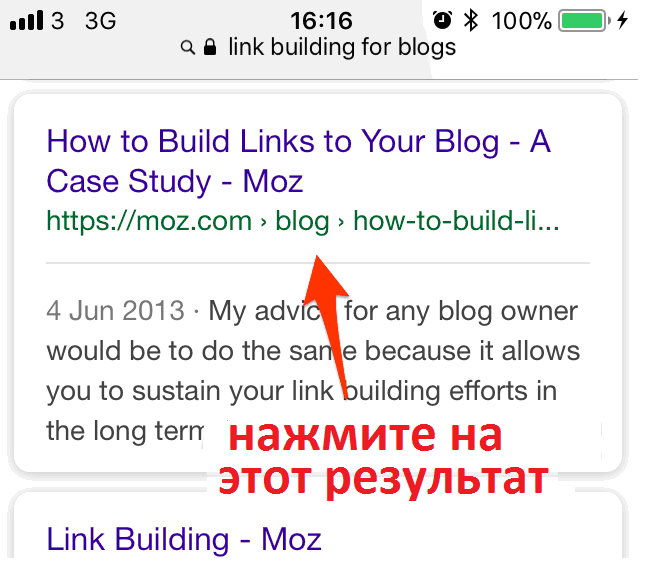
Подождите, пока страница полностью загрузится, затем нажмите кнопку «Назад». Вы заметили что-нибудь? Google добавил под результатом, на который вы нажимали, прокручиваемый список связанных по смыслу запросов.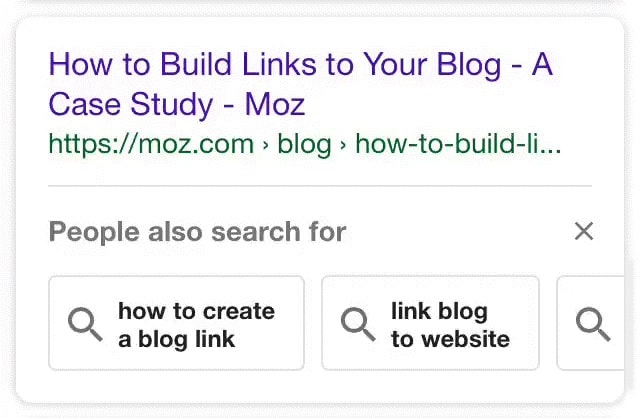
Примечание. Если это у вас это не сработало, то попробуйте нажать на любой другой результат с первой страницы – кажется, так срабатывает у большинства. А еще, я пробовал это только на своем iPhone, поэтому я понятия не имею, сработает ли это на устройствах Android.
Это вполне разумно. Так как вы вернулись к результатам поиска, то вероятно не нашли то, что искали. Таким образом, Google предлагает некоторые связанные запросы, чтобы помочь.
Это доказывает, что Google контролирует так называемое «pogo-sticking» (по крайней мере, на мобильных устройствах). И если они контролируют это, то скорее всего контролируют и Dwell Time.
Но, прежде чем вы будете слишком увлечены, позвольте мне сказать одну очевидную вещь:
Это не доказывает, что Dwell Time является фактором ранжирования.
Это только доказывает, что Google контролирует его, чтобы улучшить взаимодействие с пользователем. Тем не менее, это не мешает предположить, что эти данные могут оказаться полезными для влияния на рейтинги.
Почему не стоит полагаться на Dwell Time в качестве фактора ранжирования
Вам сейчас кажется, что идея Google использовать Dwell Time как фактор ранжирования, вполне логична и вероятна, не так ли? Как говорится: это звучит слишком хорошо, чтобы быть правдой, и, вероятно, так и есть.
Вот несколько возможных проблем с использованием Dwell Time как фактора ранжирования:
Это не работает для простых запросов в форме вопроса
Например, мы хотим найти ответ на запрос «когда вышел‘‘Robot Wars’’?».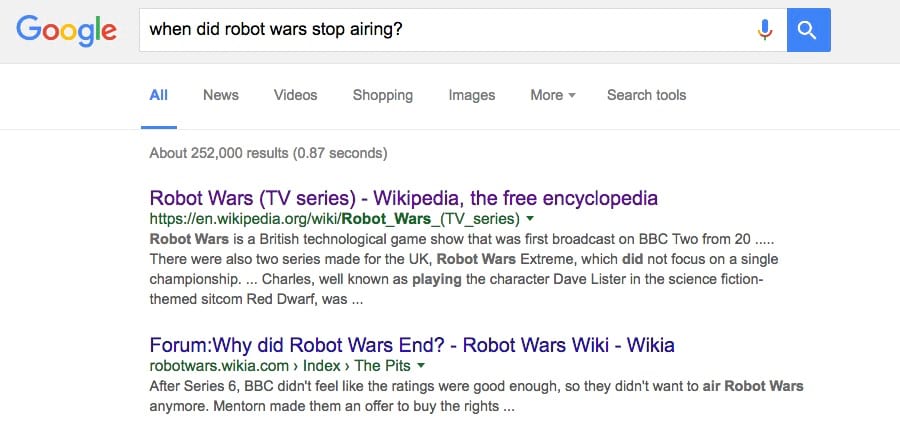
На момент загрузки страницы с результатами поиска, мы все еще не нашли ответ. Итак, нужно перейти к одному из результатов, чтобы найти нужную нам информацию. Если вы перейдете к лучшему результату (из Википедии), вы найдете ответ в первом же предложении.
Поскольку ответ был быстро найден, вы, скорее всего, вернетесь к странице с результатами поиска через несколько секунд. Таким образом, время ожидания будет довольно низким для этого запроса, в среднем – менее 10 секунд.
Но это никак не связано с плохим UX (пользовательским опытом); вы нашли информацию, которую искали, за пару секунд. Вот что Эрик Энге сказал по этому поводу:
Существует много вариантов, в которых более короткий Dwell Time является показателем качества. Например, постоянно кто-то ищет краткую справочную информацию, такую как почтовый индекс или номер телефона. Для информационных запросов, подобных этим, создаются страницы, чтобы помочь пользователям находить нужную им информацию мгновенно.
Эрик Энге, основатель компании Stone Temple Consulting
Таким образом, в этом примере короткий Dwell Time не согласуется с отрицательным опытом. Результат №1 был лучшим и наиболее актуальным результатом для этого запроса.
Это плохо работает для страниц «AFA» (случайная ложная реклама)
«AFA» – это те результаты, которые, на первый взгляд, предлагают именно то, что вы искали. Но при дальнейшем осмотре (который увеличивает время проведенное на сайте), вы понимаете, что это не так.
Пример:
Недавно я искал шаблон для Google Таблиц, способный импортировать результаты поиска Google. Я искал «google results scraper google sheets» и выбрал верхний результат, который был сайтом от SEER Interactive.
На первый взгляд это выглядело идеально.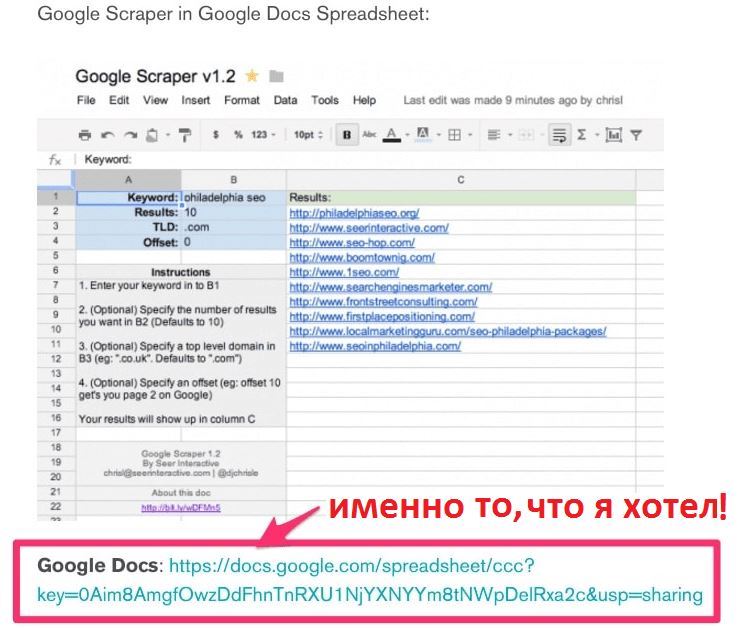
Я нажал по добавленному шаблону Google Таблиц (который открылся в новой вкладке, из-за чего я не покинул предыдущий сайт), сделал копию и попытался проверить как он работает.
Но через пару минут я понял, что электронная таблица перестала работать и выдает ошибку.
Итак, я вернулся на предыдущую вкладку (которую я не закрывал), для того чтобы проверить комментарии и посмотреть, не появилось ли у других пользователей таких же проблем. И они были.
Затем я вернулся на страницу с результатами поиска, чтобы продолжить поиск. Итак, хотя Dwell Time на сайте показала хороший результат (5+ минут), мой опыт все еще был отрицательным. Страница не отвечала моим запросам и, честно говоря, вообще не заслуживает того, чтобы попасть в десятку лучших, пока ошибки на ней не исправят.
Это не подходит для раздела «Покупки»
Еще один интересный момент, который отметил Марк Трафаген:
Еще одна версия, в котором Dwell Time может быть ложным фактором для определения качества контента и удовлетворенности пользователей – это покупки. Часто, когда я занимаюсь шопингом и сравниваю товары по ценам и другим параметрам, то могу довольно быстро перемещаться между несколькими результатами, постоянно нажимая на стрелку «назад».
Марк Трафаген, старший директор Brand Evangelism
Все, кого я знаю, делают так же при сравнении покупок. Вы нажимаете на результат, проверяете цену, возвращаетесь назад и нажимаете на другой результат. Вы повторяете эти действия снова и снова, пока не найдете лучшую цену.
Но процесс «pogo-sticking» в этой ситуации создает сценарий, в котором Dwell Time не является хорошим способом определения качества или релевантности. Это связано с тем, что нет никакой проблемы с результатами – вы просто опытный покупатель и сравниваете цены.
Итак, опровергает ли это то, что Dwell Time может являться фактором ранжирования? Не совсем. Google умный. Он может различить вопросы с коммерческими намерениями. Как? Google показывает нам только результаты покупок в таких запросах.
Пример:
Вот результаты по запросу «когда лучше пить протеиновый порошок»: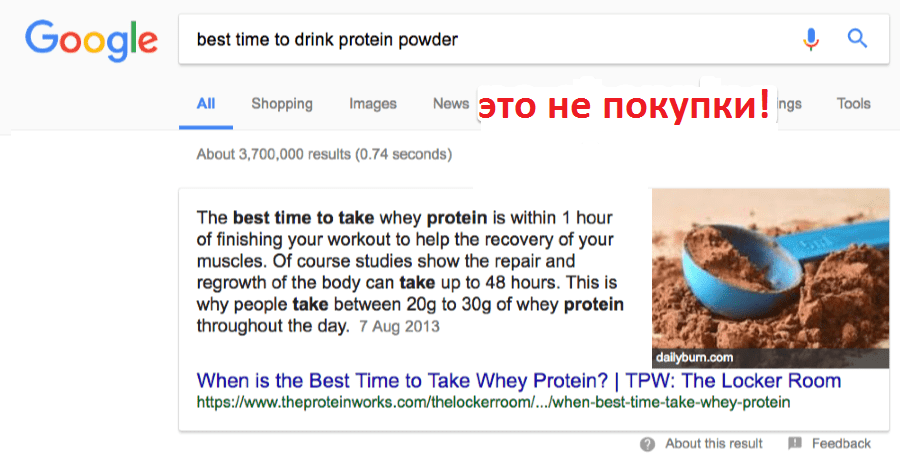
А вот результаты по запросу «лучший протеиновый порошек»: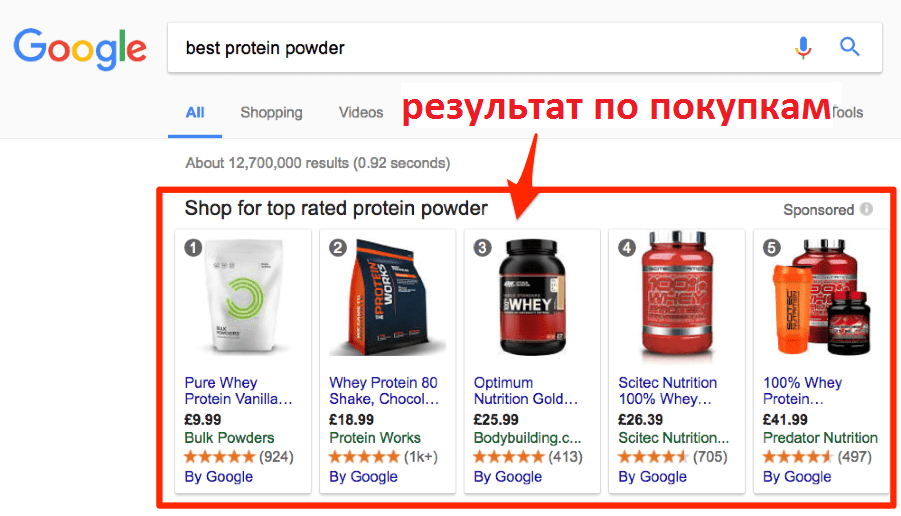
Google достаточно автоматизирован, чтобы понять, что, хоть эти запросы похожи, только один из них имеет коммерческие намерения. И если Google достаточно умен, чтобы определить это, то он почти наверняка развит настолько, чтобы игнорировать Dwell Time для коммерческих запросов.
Таким образом, даже если Dwell Time является фактором ранжирования, он, вероятно, игнорируется для запросов раздела покупок.
Стоит ли вам попытаться улучшить Dwell Time? (И если да, то как?)
Google рассматривает многие показатели вовлеченности пользователей (например, Dwell Time, коэффициент кликабельности и т.д.).
Не будьте одержимы этими критериями.
Вместо этого сосредоточьтесь на создании качественного контента и обеспечении хорошего UX. Сделав это, вам не придется беспокоиться об улучшении Dwell Time – он позаботится о себе. Я обратился к Дэнни Салливану (основателю сайта Search Engine Land), чтобы спросить его мнение обо всем этом.
Вот что он сказал:
Я думаю, Google, вероятно, пытается проанализировать и использовать активность пользователей как часть их алгоритма ранжирования. Конкретно, как это происходит, пока неизвестно, он я считаю, что большая часть оптимизаторов поисковых систем предпочитает коэффициент откликов в качестве фактора ранжирования. Это, в целом не важно. Как маркетологи, вы, прежде всего, хотите вовлечь пользователей в ваш контент. Поэтому сосредоточьтесь на этом, и вы, скорее всего, будете соответствовать требованиям Google
Дэнни Салливан, основатель сайта SearchEngineLand
Это однозначно так, но каким образом вы можете привлечь пользователей? Вот вам несколько вариантов:
1. Создайте ЛУЧШИЙ контент… Примерно от 2 до 10 тыс. символов
Довольно очевидно, не так ли? Но это не всегда означает создание более объёмного контента. Иногда наиболее подходящим результатом для места №1 является наиболее краткая статья.
Вот, что сказал насчет этого Эрик:
Бьюсь об заклад, если бы вы провели эксперимент, в котором бы определили средний Dwell Time на миллионах сайтов и их место на странице с результатами поиска, вы бы увидели тесную взаимосвязь между Dwell Time и ранжированием. Означает ли это, что я считаю это фактором ранжирования? Конечно, НЕТ. Это только означает, что существует большое количество запросов, где более продолжительный Dwell Time означает, что пользователь более удовлетворен результатом поиска, чем в запросах, где Dwell Time короткий. Вероятно, также есть много примеров запросов, в которых Dwell Time не имеет никакого значения как показатель качества.
Эрик Энге, основатель компании Stone Temple Consulting
Мнение Эрика о том, что существует «много запросов, в которых Dwell Time не важен в качестве показателя качества» является значимым. Например, результат № 1 для запроса «is it Christmas?» это сайт isristristmas.com. Это одностраничный сайт с одним словом. – НЕТ! Это, безусловно, лучший результат для этого запроса, хотя Dwell Time будет очень короткой.
2. Задавайте правильные ключевые слова (и НЕ ИСПОЛЬЗУЙТЕ “Clickbait”)
Предположим, что я написал статью в блоге под названием «продвинутый справочник по SEO». Вот так это будет выглядеть на странице с результатами поиска:
Довольно уместный и отвечающий требованиям результат, правда? Не так быстро, в этой статье я расскажу о таких вещах, как:
- Добавление ключевых слов в теги заголовков и мета-описания;
- Руководство по построению ссылок;
- И прочее.
Итак, сайт не совсем отвечает нашим запросам, как оказалось… Это яркий пример, представляющий неверное использование ключевых слов. Что-то вроде «изучение SEO» или «SEO для начинающих» подошло бы гораздо лучше для этой статьи.
Как бы то ни было, контент не выполняет свое обещание – информация в статье стандартная, а не продвинутая. Из-за этого большинство пользователей быстро вернутся к странице с результатами поиска, чтобы найти более подходящий результат.
Вот что Эрик заявил по этому поводу:
В конечном счете, то, что Google хочет видеть на вашем сайте людей, которые представляют наилучшее соответствие вашему контенту. Будьте им полезны, и тогда ваши цели и задачи будут максимально согласовываться с Google.
Эрик Энге, основатель компании Stone Temple Consulting
3. Сайт медленно загружается? Навязчивая реклама? ХВАТИТ! Сделайте UX/UI своим главным приоритетом!
У вас когда-либо бывало, что нажимаете на результат из страницы с результатами поиска и происходит следующее?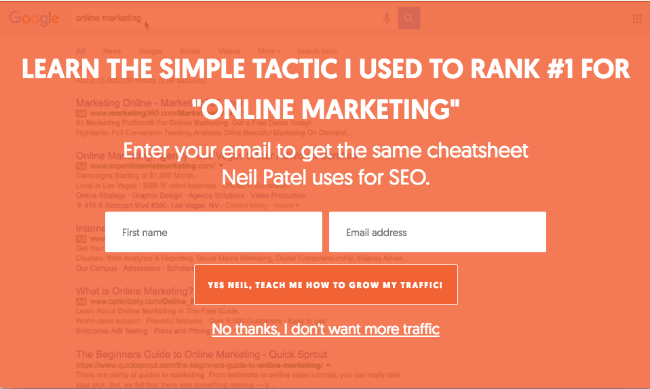
Раздражающе, правда? Для меня это мгновенная ситуация с «обратной» кнопкой, что делает Dwell Time не больше пары секунд. Но это не единственная версия плохого пользовательского опыта.
Сайт из примера Выше был жутко медленным при загрузке. Это подтвердилось результатом проверки скорости.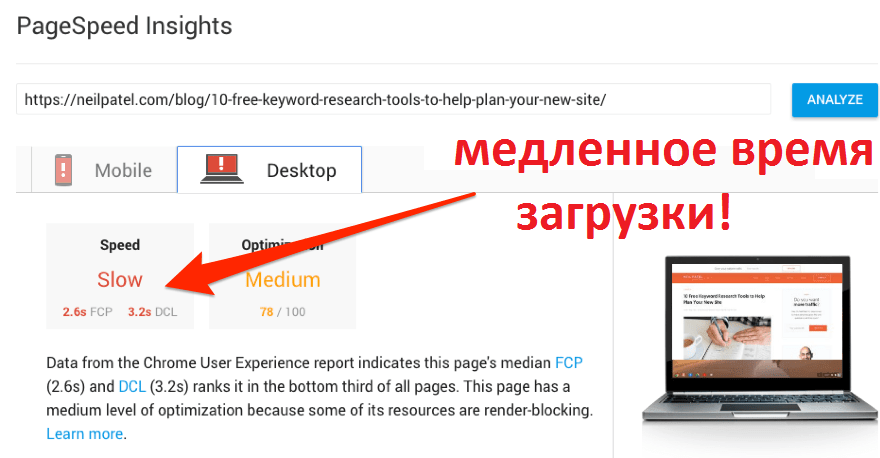
Помните о том, что 47% людей ожидают, что веб-страница загрузится через 2 секунды, а то и меньше. Таким образом, если ваш сайт слишком медленный, люди будут возвращаться к странице с результатами поиска, прежде чем он загрузится полностью.
Если это произойдет, пользователи никогда не будут взаимодействовать с вашим контентом, а Dwell Time будет равен нулю.
Вот несколько других распространенных проблем UX про которые важно помнить:
- Макет: макет вашего сайта должен быть выполнен в соответствии с приоритетностью вашего контента и обеспечивать легкое восприятие информации. Помните, что люди только один раз выбирают ваш результат из тысячи других. Они не будут читать вашу статью, если она написана желтым Comic Sans на белом фоне, независимо от того, насколько он хорош.
- Дизайн: Безобразные по оформлению сайты редко внушают чувство доверия, которое заставляет пользователей оставаться надолго. Итак, убедитесь, что ваш дизайн отвечает интересам ваших пользователей и привлекает целевую аудиторию.
- Мобильная оптимизация: даже в 2018 году многие сайты по-прежнему не оптимизированы под небольшие экраны. 9 раз из 10 случаев – это еще одна мгновенная ситуация «назад» для меня. Поэтому, даже если вы уверены, что ваш сайт оптимизирован для мобильных устройств, сделайте мне одолжение и проверьте еще раз.
- Прокрутка без разбивки на страницы: реализация непрерывной прокрутки делает чудеса для сайтов с большим количеством контента. Почему? Так легче продолжать воспринимать информацию, больше шансов, что люди останутся. Например, посмотрите на Facebook/Twitter. Сколько раз вы сидели, прокручивая свои, казалось бы, бесконечные новостные ленты?
- Реклама: никто не любит навязчивую рекламу, и Google это понимает. В феврале 2018 года Google Chrome начал блокировать такую рекламу по умолчанию. Так что, не стоит покрывать рекламой всю страницу – вы все равно не будете зарабатывать много денег.
4. Небольшое количество внутренних ссылок на протяжении всего вашего контента будет кстати… но убедитесь, что они уместны!
Внутреннее ссылки не связаны с алгоритмом ссылочного ранжирования PageRank на вашем сайте (хотя есть исключения). Речь идет об улучшении пользовательского опыта.
Пример:
Google Таблицы – один из инструментов, упомянутых в нашем списке из 70 + бесплатных инструментов SEO-специалиста. Ниже этого упоминания мы ссылаемся на наш список из 10 таблиц Google Таблиц, которые должен знать каждый SEO-специалист.
Это работает, потому что мы направляем посетителей на контент, который может быть им интересен. И уместно в контексте статьи. Это также увеличивает вероятность того, что посетители просмотрят более одной страницы вашего сайта. Это уменьшает частоту отказов, увеличивает Dwell Time и улучшает общее взаимодействие.
5. ВСЕГДА следите за актуальностью вашего контента (Несвежий контент =Провал!)
Весь контент постоянно обновляемый.
Пример:
В 2016 году мы опубликовали огромный список из более, чем 200 советов по SEO.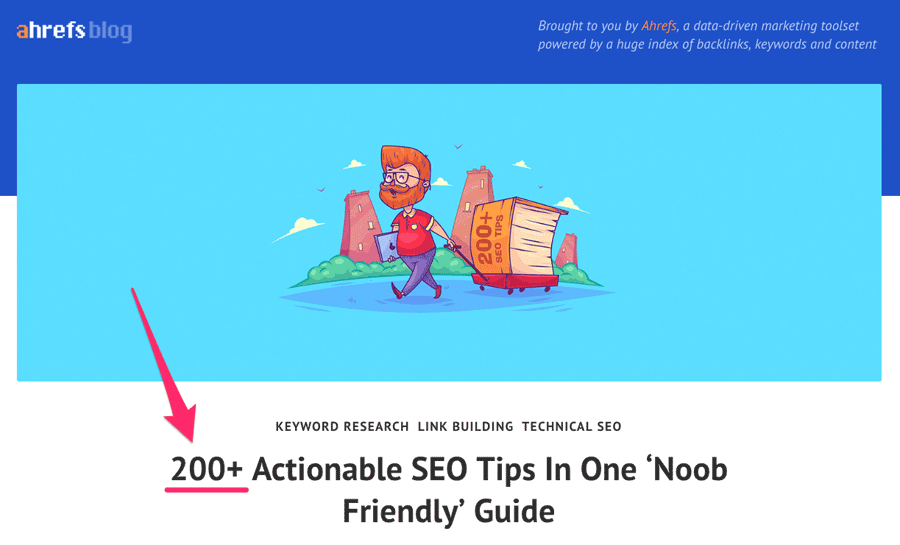
Но SEO – одна из наиболее обновляемых тем. И, когда мы рассмотрели статью в 2017 году, мы поняли, что многие советы были устаревшими. Мы также заметили, что многие из 200+ советов были полной чушью.
Итак, мы решили удалить мусор и сократить пост до лучших 75 советов.
Мы рекомендуем постоянно обновлять статьи в блоге. Зачем? Потому что люди чаще доверяют недавно обновленным статьям. Это увеличивает CTR (кликабельность ссылки) на странице с результатами поиска и обеспечивает более эффективное взаимодействие с контентом в целом.
Заключительные мысли
Dwell Time – это то, с чем Google экспериментировал и на чем проводил исследования. Но это не значит, что это фактор ранжирования. Или хоть сколько-нибудь надежный способ оценки качества и релевантности результатов поиска.
Нет. Когда дело доходит до Google, есть только один неоспоримый факт: они хотят сделать своих пользователей счастливыми. И это означает показ лучшего, наиболее релевантного результата в месте №1.
Ваша задача – быть этим результатом.
Итак, создавайте качественный контент, который соответствует желаниям вашей целевой аудитории. И будьте уверены, ваш сайт с удовольствием посетят. Сделайте эти две вещи последовательно, и вам не придется беспокоиться о Dwell Time.
Перевод статьи с ahrefs.com/blog/dwell-time/
Эксперт в области интернет-маркетинга. Руководитель маркетингового агентства MAVR.
Бизнес-степень «Мастер делового администрирования» (MBA).


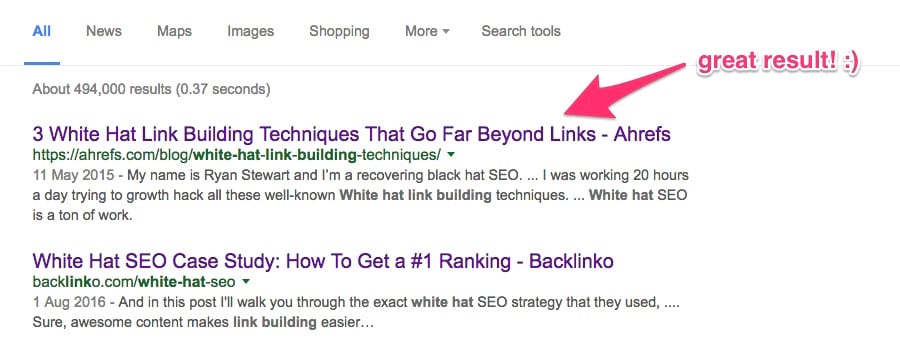
Я правильно понял, что по сути это время равно простому времени нахождения пользователя на сайте? К примеру, если я зайду на jobni.ru/?city=69194&show=false, а после решу искать вакансии на ekateriburg.hh.ru, то вернусь на ту же страницу чтобы перепрыгнуть с 1 на 2?
Согласен, конечно, что не стоит на этом особо заостряться. НО если этот фактор так важен, стоит серьезней задуматься как задерживать пользователя на сайте.
Михаил, все верно! Спасибо за комментарий!